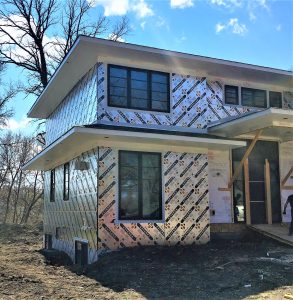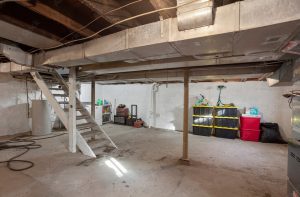As energy codes change to align with a net-zero future, their thermal resistance standards become more onerous. Continuous Insulation (CI), such as Halo’s Exterra series, offers an effective way to meet these strict new requirements.
This post will examine the current energy code standards in Canada and the US and discuss a CI layer’s value in mid-rise building wall assemblies.
Creating a CI Layer With Halo's Exterra
Halo’s Exterra series is a rigid insulation product, comprising a Neopor Graphite Polystyrene (GPS) foam core and 2 layers of perforated laminate. It’s tailor-made for exterior applications and makes an efficient continuous insulation layer.
Using Halo Exterra in the exterior of your above-grade wall assembly, you can eliminate thermal bridging and efficiently meet the code R-value requirements. Exterra’s GPS core and perforated laminate coats create a high-performance CI layer, which adds R-value to the wall, and serves as a water-resistive barrier while letting the assembly breathe.
Thanks to the perforations, Exterra — unlike leading XPS brands — does not create a double-vapor barrier.
But using a CI layer like Halo’s Exterra can do more than just help you meet the code. A recent hot box test revealed that a layer of continuous insulation could add thermal lag to a wall assembly.
This effect delays the building’s heat loss when outdoor temperatures drop. With more thermal lag, a property’s heating and cooling equipment can remain idle longer before indoor temperatures get low enough to trigger the thermostat.

Current Canadian Code Requirements for Above-Grade CI in Mid-Rise Buildings
Per the current Energy code in Canada, above-grade walls require effective R-Values ranging from R-18 to R-31, depending on the climate zone. Here’s a brief geographic breakdown:

Keep in mind that these R-Values are set to rise dramatically over the next decade, as the Energy Code becomes more demanding in its quest to achieve net-zero-readiness (NZR) by 2030. CI will become the norm in meeting these stringent thermal performance requirements.

Don't miss a thing!
Subscribe for exclusive content, insider industry news and limited edition webcasts.
Current US Code Requirements for Above-Grade Continuous Insulation in Mid-Rise Buildings
In the US, energy codes already demand CI in several scenarios. R-20 is the minimum thermal resistance for buildings in Climate Zones 1-4, representing the hot and mild regions, with potentially lower R-values permissible if CI is used. In Climate Zones 5-8 — which straddle the Canadian border, the Rockies, and Alaska — CI is mandatory in all wall assemblies.
Here is a brief summary of the requirements:

Wrapping It Up
If you’re building a mid-rise residential building in Canada or the US, adding CI, such as Halo’s Exterra, to your wall assembly can simplify your path to code compliance. In certain climate zones, a CI layer is mandatory. Apart from helping you keep up with the evolving energy code regulations, designing walls with CI like Exterra can also lessen the load on your conditioning systems and curb your property’s operational costs.







